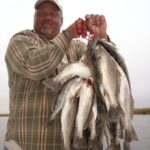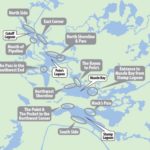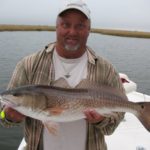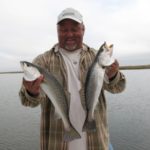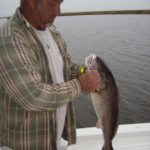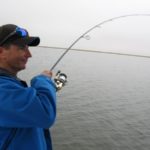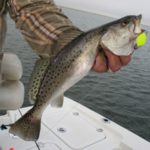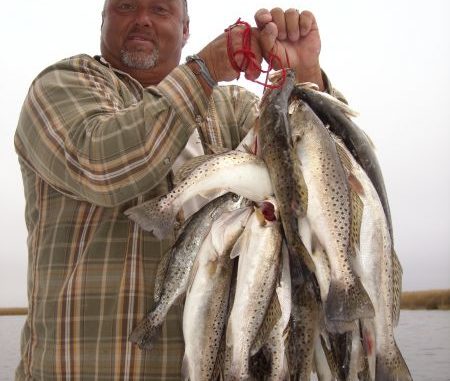
If you’re looking to fill your boat with trout and reds, the Biloxi Marsh’s Stump Lagoon and its surrounding waters offer plenty of options.
If you leave out of my launching pad in Shell Beach you can enter the Biloxi Marsh by one of two general routes. Either you cross Lake Borgne and enter through one of the numerous bayous that wind snakelike into the heart of the marsh, or you head up Bayou LaLoutre and enter through Stump Lagoon.
I always went through Stump because I thought access to the interior was easier that way. Truth be told, the Stump Lagoon route might be a bit longer than the across-the-lake route — depending on your destination in the marsh — but it is an easier route to follow.
And while it can still be a bit confusing if you don’t pay attention, it’s not nearly as confusing as the other options. And, besides, there are a bunch of places to stop and fish along the way.
But a lot has changed since the days we studied our map as we meandered through the marsh and hoped we actually were where we thought we were. That’s always been the problem with the marsh: There are no street signs telling you which canal or bayou it is that you’re looking at. It’s so easy to get turned around and lost, or at least it was.
Technology has changed all that with the introduction of the GPS, and some of the software now available for your GPS can actually make it impossible to get lost anywhere in the marsh, no matter how unfamiliar you are with the area.
Yep, you heard me: impossible to get lost.
Not long ago, Glenn Schurr (owner of Standard Mapping, the folks who produce those colorful aerial charts of all our favorite fishing grounds) developed a chip that will load almost any of those maps directly into your Lowrance GPS. The difference it makes is phenomenal.
The charts that came preloaded in your GPS are lame by comparison to the Standard Map Chip, which is the actual up-to-date aerial map of the area. Standard calls it the E-Card, and it works on all Lowrance HDS models and on the Elite-7 HDI, and on Simrad.
The cards typically cover about the same area as a printed map, and combo cards contain multiple maps joined together for a larger area of coverage. The first time I saw it in actual use I was so impressed I went home and sold my perfectly good GPS and bought a Lowrance, just because it can run this map chip.
And I’m more impressed with it the more I use it. I’m almost fearless now as I zip-a-dee-doo-dah through the marsh like those people who’ve done it for years.
A bit of caution is still needed because, while you can’t get lost (zoom out and you’ll know exactly where you are and how to get home at all times), you can still run aground in shallow water.
But my point is, with the chip in my GPS I don’t hesitate to run into the deep marsh interior from any access point, as long as I’m confidant of enough water to run in.
So I was prepared for a recent early afternoon trip with a fishing buddy, Kevin Bergeron. Of course, it helped that Capt. Casey Kieff offered to jump aboard to see if he could guide us into some fish before it got dark. With daylight ending so early, I knew it’d be a challenge to pull off a productive trip.
Kieff said as we now move into the heart of winter we can expect more-frequent fronts, lower water levels, and lower air and water temperatures.
All of that combines to mean the trout and redfish will move into the deep interior canals and bayous, and their metabolism slows significantly.
Live bait is less of a necessity, since winter trout generally hit soft plastics pretty readily, but you do have to slow down your usual fishing technique. Slower retrieves, slow hops and drags along the bottom and up and down ledges, and slower and more-patient fishing under corks is absolutely necessary for success.
Kieff brought us to several of lagoons, where we fished mostly with Vudu shrimp under popping corks, and we caught specks at every stop.
None of the fish were huge, which is pretty typical for this time of year, but the fish were plentiful and mostly keeper size.
Points and places with good current movement were most productive, and we had our two man limit by 4:30 p.m., leaving us enough time to get back to the dock before dark.
Our three most-productive baits of the day were the white Vudu shrimp with pink tails or the same bait with chartreuse tails, along with the Matrix shad in shrimp creole/chartreuse tail.
Kieff said if the winter remains mild to moderate the trout will be thick in these spots throughout the month:
Stump Lagoon
Stump Lagoon was once a cypress swamp. Legend says the trees were cut down over 100 years ago for use as a roadbed for wagons when sugar cane was grown and harvested on plantations. Over time, the story goes, water levels rose and much of the land and the log road disappeared in the soft bottom, leaving only the cypress stumps protruding above the surface — hence the name Stump Lagoon.
Fast forward to the present, and even the stumps are submerged and deteriorated to the vanishing point. Now few remain.
Kieff said Stump Lagoon might lack its namesake stumps, but it does have specks.
“I have three favorite areas in Stump,” he said. “One, I like to drift or troll the south shoreline, staying about casting distance off the bank, and I toss plastics or live bait under a cork
“If the water level is low, I don’t fish this spot; but if you have good water levels, give it a try. Stick your Power-Pole or Cajun anchor when you catch a couple fish, and resume drifting or trolling when the action plays out.”
His second hotspot in the lake isn’t exactly a secret.
“No. 2 is probably the best-known area to fish in Stump: Mack’s Pass,” Kieff said. “It’s a common-sense spot because Mack’s Pass is one of the main passes draining the upper marsh down through Stump and into Bayou Loutre.
“It’s a funnel, where concentrations of bait flow through like an undersea highway, and when the tide is moving the action can be nonstop.”
Live baits or soft plastics under corks work well there.
There are challenges to working this area, however.
“That’s the pass that takes you up into Muscle Bay and, while it definitely holds fish this time of year, it has two drawbacks,” he said. “It gets a lot of traffic through it, which can disrupt your action, and when its producing it attracts crowds like lice to a school kid — especially on weekends.”
That doesn’t mean you can’t catch fish there, however.
“There’s several ways to fish it,” Kieff said. “You can go up into the pass itself and anchor slightly off to the side and toss your bait toward the channel, or you can troll or drift the channel, depending on the boat traffic.
“And you can fish in Stump itself around the mouth of the pass, where you’ll usually see boats anchored.
The third area Kieff likes in Stump Lagoon is the northwest corner.
“You can actually fish the whole shoreline going west from Mack’s Pass,” he said. “I like to drift or troll within casting distance of the bank, and toss live baits or market shrimp or Gulp!s under a cork toward the shoreline for reds, or toss soft plastics under a cork away from the bank toward the middle for specks.”
Muscle Bay (Mussel Bay)
This is a perennial hotspot, and the next stop on your way into the deeper interior. Kieff said he has three specific locations in Muscle Bay that should pay off in speckled dividends.
“One, fish the mouth of Muscle Bay when you first enter it coming up from Stump Lagoon, (fishing) under a cork,” he said. “You can anchor or drift, and stick when you catch a fish or two.
“You can usually pick up some nice trout right there whenever you catch a good moving tide, whether rising or falling.”
The second site is at the mouth of the bayou that goes up to Pete’s Lagoon.
“Anchor on either side and throw back into the channel, either under a cork or on the bottom,” Kieff said. “If you like to tight-line plastics, this is a good place to do it; just remember to slow down your retrieve and use smaller baits.”
Kieff said this canal also is a very good place to troll, tight-lining soft plastics.
He’ll then make a stop in the northwest corner of the bay.
“You can anchor and toss toward the shore for reds or throw out for specks, Kieff said. “I like to drift it and stick the Power-Pole when we catch some fish. Soft plastics under a cork for trout, live or market bait or Gulp!s against the bank for reds.”
Pete’s Lagoon
“When you come up from Muscle Bay toward Pete’s you can turn left or right at the pipeline canal,” Kieff said.
When he enters the lagoon, he hangs a left and makes three stops, the first of which is in the southwest end of the bay.
“I anchor in the middle and cast in all directions for specks,” Kieff said. “Or I fish the north shoreline where you can anchor, or if you catch the wind right you can drift or troll within casting distance of the bank and throw against the shore for reds and out into the lagoon for specks, under a cork.
“Then you can try the pass. It’s not deep, maybe 4 feet or so, but it holds trout. Anchor or drift and toss your plastics under a cork or tight-lined.”
You have to be willing to put up with passing boats, however.
“The possible drawback here is this spot can get a lot of boat traffic on weekends,” Kieff said.
Cutoff Lagoon
Again, Kieff has three hotspots to suggest.
“At the mouth of the pipeline when you enter Cutoff is a good place to drift or troll for both reds and trout,” he said. “Fish tight-lined or under a cork, and fish against the bank for reds.
“The north side is a good place to drift within casting distance of the bank for reds, or toss out for specks, all under a cork. And the east corner of Cutoff usually holds trout, and soft plastics under a cork will get the bite.”
